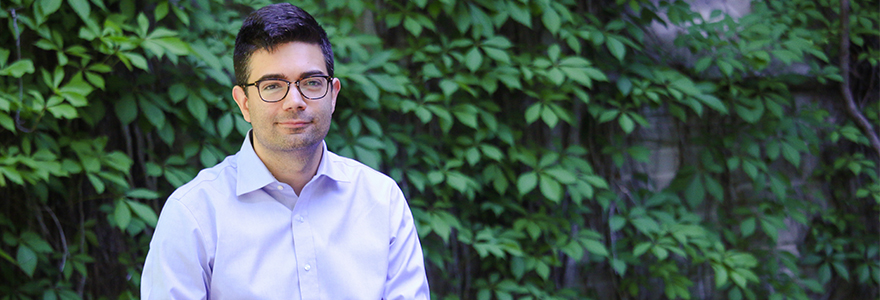Departments and Units
Contact
Communications Specialist
Faculty of Engineering
Spencer Engineering Building
Room 2072
Western University
Tel: 519-661-2111 ext. 87015
Email: engineeringcomms@uwo.ca
Combining theory and experiments to tackle optoelectronics

Dr. Eric Johlin is the newest faculty member in the Department of Mechanical and Materials Engineering, where he is entering his first official faculty position as an Assistant Professor.
Johlin completed his undergraduate degree at the California Institute of Technology (Caltech), where he started studying applied physics and mechanical engineering. He went on to complete both his Master’s and his PhD in mechanical engineering at the Massachusetts Institute of Technology (MIT), and for the three years following his PhD, Johlin performed post-doctoral work at AMOLF's Center for Nanophotonics in Amsterdam.
Why Western?
“Western was particularly attractive to me for a number of reasons,” said Johlin. “My work is quite interdisciplinary, combining aspects of applied physics, electrical engineering and chemistry. The encouragement toward interdisciplinary work here at Western was very attractive.”
Johlin added that finding a school with a supportive environment was a personal priority.
“It is clear that people here really care about supporting and helping out their colleagues, as opposed to competing against them,” he said. “Western has exceeded my expectations on this.
“I was also lucky to join Western Engineering at a very exciting time. With the faculty expanding quickly – and in particular the Mechanical and Materials Engineering department — it is not only an encouraging sign of the prosperity and success of the faculty here, but it also makes it quite compelling to see where the future of Western Engineering will go.”
Optimizing optoelectronics
Johlin’s research interests lie in developing new devices and materials, and in expanding the understanding of optoelectronics, particularly in relation to the creation of clean energy and photovoltaics – the conversion of light into electricity. Specifically, Johlin’s work focuses on the use of nanostructures to improve performance and create a new level of functionality that would otherwise not be possible in photonic devices used to create and manipulate light.
The extensive photovoltaic research that was being performed at MIT drew Johlin to the school’s mechanical engineering program. During his graduate studies, Johlin participated in two separate research groups, which took two entirely different approaches to their process of inquiry. One group focused on manufacturing, looking at ways to improve devices and understand their defects, while the other was based on simulation and theory in order to better understand materials and their properties.
“These groups were disparate in terms of the techniques used, but it was a nice experience in that it gave me the chance to combine those two skill sets and look at a range of focus areas, from the atomistic scale through the nanoscale to the macroscale,” said Johlin.
Johlin has carried the approach of combining simulations and theory with experimental work into his career. He noted that often engineers consider themselves to be experimentalists and find theory intimidating; the reverse is true as well.
“Neither one is inherently more difficult than the other,” said Johlin. “Having early exposure [to this two-sided approach to research] makes your work easier down the road, and that’s one thing I’m trying to do here at Western, so that students can have exposure to both sides of research.”
In Fall 2018, Johlin will be teaching a third-year undergraduate design course that explores better ways to choose materials used to create products and devices.
“This course goes into a more rigorous way of deciding on the best material for an application, as opposed to just using what you’re most familiar with,” said Johlin. “We’ll look at weighing the tradeoffs of material properties, tensile strength and density for example, and how you can use this information to look at what materials give you the best performance for your design.”
Since joining Western Engineering, Johlin has created the Nanophotonic Energy Materials group, which explores new structures, materials and systems utilizing nanophotonics for photovoltaics and other optoelectronic devices.
Master’s and PhD students with an interest and background in nanophotonics or optoelectronics are encouraged to contact Dr. Johlin for more information.

